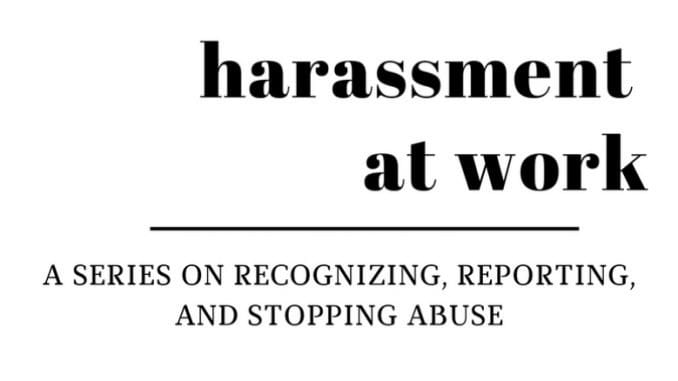
Harassment at work is real, but what do you do when it happens to you? How do you know when someone’s behavior has crossed the line? And who do you tell when it happens to you? In this eight-part series, we break down what harassment is and what to do about it.
BY ASHLEY RODRIGUEZ
BARISTA MAGAZINE ONLINE
Note: This series will explore issues of harassment and recount episodes of alleged harassment in the workplace. If you are sensitive to stories and scenarios depicting workplace harassment, please be advised.
This series is an accompaniment to the February + March 2018 article, “Coexisting at Work: Sexual Harassment Policies,” written by Lauren Lathrop. It’s meant to define sexual harassment and provide a blueprint as to how to handle workplace harassment. In the first part of this series, we defined harassment and talked about some of the ways a person can be harassed at work. In part two, we’ll talk about some of the legal protections in place to protect employees from workplace harassment.
Harassment can include any number of behaviors—an offensive joke, an unwelcome touch, a put-down based on one’s identity—but what’s important to note is that harassment is decided by the person who is being victimized or by a person witnessing the offending behavior. Harassment doesn’t need to be reported by a person directly experiencing the behavior, and harassment can occur between employers, supervisors, employees, coworkers, and non-employees. There is no specific set of behaviors or hard and fast rules to define harassment; it is up to the persons who experience and witness the behavior to define if they feel the behavior is harassment.
So how does the government protect employees from harassment? Up until the 1960s, there were no legal protections in place if someone experienced harassment at work—if an employer didn’t want to hire someone based on their race or gender, they didn’t have to, and there was no recourse for potential and current employees to report discriminatory behavior. In 1961, President John F. Kennedy signed Executive Order 10925, which required government contractors to “take affirmative action to ensure that applicants are employed and that employees are treated during employment without regard to their race, creed, color, or national origin.” Shortly thereafter, the Civil Rights Act of 1964 was voted into law, which outlawed discrimination based on race, color, religion, sex, or national origin.
The Equal Employment Opportunity Commission (EEOC) is a federal bureau that was created to enforce Title VII of the Civil Rights Act, along with other legislation that has been subsequently voted into law to protect people from discrimination at work such as Title I and Title V of the Americans with Disabilities Act of 1990 (ADA) and the Age Discrimination in Employment Act of 1967 (ADEA). It’s important to discern that the EEOC is not a law-making body, but takes the statutes that have been voted into law and interprets how these laws will be protected and enforced. It is also the responsibility of the EEOC to hear grievances and file lawsuits against employers if they violate the laws the EEOC is responsible for enforcing.
Just because there are laws in place doesn’t mean that employers are suddenly following them. According to the EEOC, 84,254 claims were filed with their office—33.9 percent of those claims mentioned being discriminated against based on race, 30.4 percent mentioned gender, and many mentioned being discriminated against on more than one trait. Although the number of claims the EEOC has heard is staggering, it’s impossible to know just how often workplace harassment happens because many claims go unreported.
Another important note about harassment is that the EEOC generally does not define one-off behaviors as harassment, except if they are extremely serious. “Petty slights, annoyances, and isolated incidents (unless extremely serious) will not rise to the level of illegality. To be unlawful, the conduct must create a work environment that would be intimidating, hostile, or offensive to reasonable people,” the EEOC notes.
When it comes to harassment in the workplace, it is the responsibility of your employer to stop the offending behavior. However, employers are technically not responsible for preventing harassment (although the EEOC suggests that prevention is the single-biggest deterrent of harassment), but are liable (meaning legally responsible) for stopping and preventing harassment once they know about it. If you’ve read any articles about the ensuing harassment claims against employers, there’s often mention of management not doing anything, or an employee reporting harassment to human resources and nothing happening—these details are relevant because knowingly allowing harassment to occur is when a company becomes legally responsible for harassment.
Let’s look at an example. If a coworker says something to you that feels like harassment, your employer is only legally liable for the harassment if they knew about it and did nothing to stop it. If you tell your HR manager or a supervisor and the harassment stops, then your employer legally did their job. Your employer is not responsible for telling you what they did or how they stopped the harassment—the harassment just has to end.
Although these definitions can seem restrictive, it’s important to know that the EEOC is designed to protect you against harassment from anyone you interact with at work; it doesn’t just protect you against your coworkers, but it protects you against supervisors, bosses, and even customers and non-employees. In many states, protections for employees are even broader, and include more groups of people and types of harassment. If you report harassment, you are legally protected from retaliation from your employer; even if the harassment stops from the perpetrator, you might still have grounds to file a complaint if your employer then retaliates against you by calling you a “trouble-maker” or making your work more difficult. (The EEOC reports that retaliation is “the most frequently alleged basis of discrimination in the federal sector and the most common discrimination finding in federal sector cases.”)
Now that we’ve gone over the laws and what they mean, we’ll talk in the next installment of this series about the single-most important thing to know about proving a harassment claim: documentation.
Disclaimer: This article is meant to be informative and provide guidance. This is not meant to be legal advice. This publication is read by a variety of people all over the world, and laws regarding workplace harassment can vary wildly. If you are thinking about filing a workplace harassment lawsuit, please consult a licensed attorney in your state or jurisdiction.

